The 10 Best Shock Collars for Dogs to Buy in 2026

We all love our adorable little fur babies. But sometimes, their unruly behavior and incessant barking are enough to drive even the most patient pet owner mad. And because the services of a professional dog trainer cost a significant sum, it’s little wonder many Americans opt for an affordable alternative: the shock collar for dogs.
Also known as e-collars and training collars, these high-tech gadgets can correct the poor behavior of even the most mischievous pooch. And when used in a responsible manner with care and compassion, there’s no need to worry about harming your four-legged friend.
Today we’re going to present the top 10 shock collars for dogs and provide in-depth information on the revolutionary product in our comprehensive buyer’s guide.
- Features to Consider
- Top 10 Best Shock Collars for Dogs 2026
- 1. Best Overall Pick: DOG CARE Dog Training Collar
- 2. Best Waterproof Shock Collar: Flittor Dog Training Collar
- 3. Best Budget Pick: Dimunt Dog Training Collar
- 4. Best Shock Collar With Barking Sensor: DOG CARE Dog Bark Collar
- 5. Best Premium Pick: PetSpy P620
- 6. Best for Two Dogs: Bousnic Dog Training Collar
- 7. Best Long Range: PETDIARY Shock Collar for Dogs
- 8. Best Citronella Spray Collar: WWVVPET Citronella Dog Training Collar
- 9. Best for Small Dogs: Enrivik Small Size Dog Training Collar
- 10. Safest Shock Collar: Authen Bark Collar
- Shock Collars for Dogs: Buyer’s Guide
- Shock Collars for Dogs: Final Thoughts
Features to Consider
Before we present our thoroughly researched list of the top shock collars on the market, you need to understand the key features to consider. Every dog has different behavioral issues to address, and every owner has a unique training style. Thus, there’s no single product that will always achieve optimal results.
Take the following features into consideration to ensure you’re purchasing the best possible shock collar for both you and your pooch.
Modes
The best shock collars feature multiple disciplinary methods, and it’s always wise (and humane) to consider the shock setting as a last resort. Try purchasing a collar with an audio and vibration setting to train your dog without pain before resorting to a zap.
Remote Training or Bark Sensing
While some shock collars automatically activate at the sound of a bark, others allow the owner to administer a punishment manually. The latter is ideal when you want to correct bad behavior rather than an annoying bark.
Range
If you’re trying to manually train a farm dog with access to a spacious paddock, you’ll need a longer remote control range than the average urban user. We’ve included the range in the ‘Quick Facts’ section of our list to make the selection process easier for you.
Battery Life
Swapping the collar on your doggo too often is a tiresome chore, so it’s crucial to factor battery life into the decision making process. Wherever possible, we’ve included this information in our reviews.
Budget
Even though shock collars for dogs are substantially cheaper than a professional training service, the top-end models still cost a considerable sum. Determine what your must-have features are and look for a product that aligns with your budget.
Now that you know what to look out for, here are our picks for the top 10 shock collars for 2026.
Top 10 Best Shock Collars for Dogs 2026
1. Best Overall Pick: DOG CARE Dog Training Collar
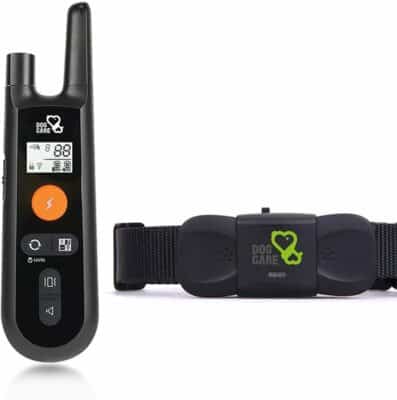
Editor’s Rating:
Why we like it: This low-cost dog shock collar from DOG CARE ticks all the boxes in terms of features and functionality.
Quick Facts:
- Modes: Vibration / Sound / Shock
- Remote Training or Bark Sensor: Remote Training
- Range: 1,000 feet
- Battery Life: Receiver 15 days / Remote 45 days
Looking for a cost-effective yet highly functional shock collar that delivers the goods? Then look no further than the Dog Training Collar from DOG CARE.
This nifty collar is the highest selling product on Amazon, and it’s not hard to see why. For a very reasonable price, you’ll get the three primary modes wrapped into one—vibration, beeps, and shock. The electric shock component comes in an impressive 99-point configuration. In short, that means you can fine-tune the perfect static discharge your pet will immediately notice without putting them in unnecessary pain.
There’s no bark sensor included in this model (or in any remote training collar, for that matter), so you’ll have to manually buzz your pooch to keep them quiet, which is rather challenging when you’re not home. This is unfortunate because plenty of people prefer this approach as it allows you to let doggo bark from time to time, yet intervene when the yaps become too much.
It works wonderfully on dogs of most shapes and sizes (between 15lbs and 100lbs) and comes with a handy safety lock, so you don’t accidentally zap your four-legged friend. The system can even work simultaneously with up to nine different collars at a time (heaven forbid you have that many doggies in your home). A long-lasting battery and an impressive 1,000-foot range are the icing on the cake.
Pros
- Affordable dog shock collar
- Highly adjustable 99-point shock setting
- Safety control on the remote
- Long-range remote
- Fits a wide variety of canines
Cons
- Doesn’t fit very large or small dogs
2. Best Waterproof Shock Collar: Flittor Dog Training Collar
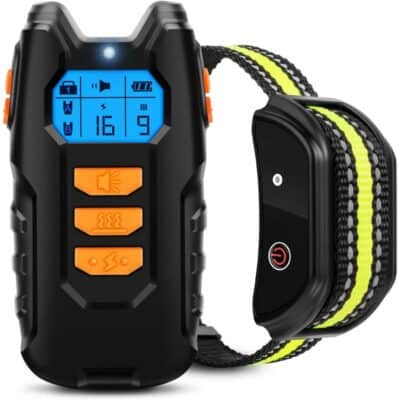
Editor’s Rating:
Why we like it: This affordable dog shock collar comes with all the essential features in a sturdy waterproof shell.
Quick Facts:
- Modes: Vibration / sound / shock
- Manual Training Or Bark Sensor: Remote Training
- Range: 1,000 feet
Does your dog love splashing about in every puddle they find? Then you’re going to want a waterproof shock collar, and this superb option from Flittor fits the bill. The device comes with a sturdy IPX67 waterproof rating so your pet can swim to their heart’s content without shorting any circuits.
Although it doesn’t perform quite as well as many of the other options on our list, it’s not too shabby considering the price point at play. You’ll get eight sensitivity settings on the vibration mode and 16 on the shock function, plus a far-reaching range of up to 1,000 feet.
There’s no bark sensor here, so look elsewhere if you’re not prepared to personally zap your pooch. At least it does have a built-in security lock on the remote to prevent those unfortunate accidental discharges.
An LCD on the remote provides the essential info at a glance, but it’s not as easy to read and comprehend as some of the more high-end models we recommend. You can also only train two dogs simultaneously, although that should be enough for most of us.
Pro tip: If you’d like two receivers, opt for the double-receiver model instead of buying the same item twice.
Pros
- Solid case with IPX67waterproof rating
- Three modes of operation
- Cost-effective solution
- High 1,000-foot range
- Safety lock on the remote
Cons
- No barking sensor
- LCD isn’t the best
3. Best Budget Pick: Dimunt Dog Training Collar
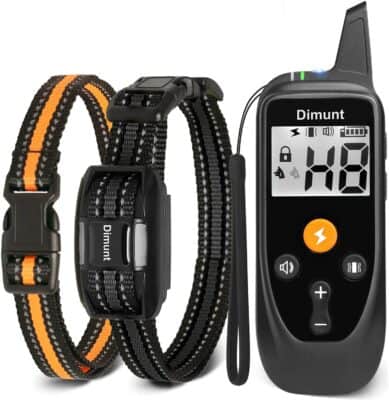
Editor’s Rating:
Why we like it: It’s packed full of fancy features and comes in at a super low price.
Quick Facts:
- Modes: Vibration / Sound / Shock
- Remote Training Or Barking Sensor: Remote Training
- Range: 1,000 feet
- Battery Life: Receiver 15 days / Remote 45 days
Coming in at under the $20 mark, this ultra-low-cost dog shock collar represents brilliant bang for your buck. If you’re looking to discipline a naughty pooch on an especially low budget, you won’t find a better option than this.
The device comes with three response modes—sound, vibration, and shock—and you can configure the electric shock setting for up to 99 points of sensitivity, which rivals some of the premium options on our list.
The built-in lithium battery on the receiver is substandard, but at least it’s rechargeable and turns off after two minutes of inactivity to extend battery life and reduce light pollution. Another standout feature is the super comfortable silicone pads attached to the nylon collar that provide added comfort for your canine.
It’s suitable for slightly bigger dogs than most other collars, with a maximum recommended weight of 110 lbs.
Pros
- Cheapest shock collar on the market
- 99-point electric shock
- Lithium battery automatically turns off
- Comfortable silicone pads
- Suitable for slightly bigger dogs than most
Cons
- Battery isn’t the best
4. Best Shock Collar With Barking Sensor: DOG CARE Dog Bark Collar
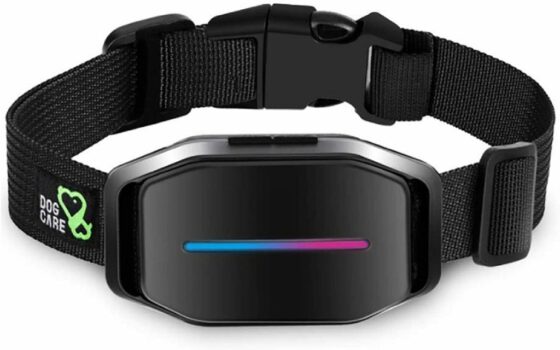
Editor’s Rating:
Why we like it: Its built-in bark sensor automatically disciplines your dog, so you don’t have to lift a finger.
Quick Facts:
- Modes: Vibration / Shock
- Remote Training Or Bark Sensor: Bark Sensor
- Range: N/A
- Battery Life: 7 days
If you don’t like the thought of consciously disciplining your dog or you need an automated device to stop them barking when you’re not home, then check out the Dog Bark Collar from DOG CARE.
There’s no remote and no manual shocking function to contend with here—the automatic bark sensor gives your pet a predetermined jolt on your behalf. And for many dog owners (including ourselves), the freedom of not having to do anything yourself is a significant selling point to consider.
Sadly, the lack of remote means you can’t use it for manual training, so give this one a pass if you’re a hands-on type of dog owner. It doesn’t have many modes (only shock and vibrations) or adjustable sensitivity points (only five on shock mode) either, so you’ll need to be extra careful not to set the zapper too high.
On the plus side, it’s fantastic at avoiding unjust shocks as the barking sensor only triggers when sound is emitted at 113 DB or more within 0.8 inches of the microphone. Consequently, you won’t have to worry about any nearby canines setting it off by mistake. It also boasts a handy safety protection system that disables the device after 30 seconds of inactivity.
Note that the strap, which can be adjusted between 8.8 inches and 20.8 inches, isn’t suitable for dogs under 22 pounds (who tend to bark more than most!).
Pros
- Automated bark sensor doesn’t require human intervention
- Sensor only triggers for loud and nearby barks
- Safety shut off feature for inactivity
Cons
- No manual training option
- Not suitable for smaller dogs
- Limited modes and sensitivity settings
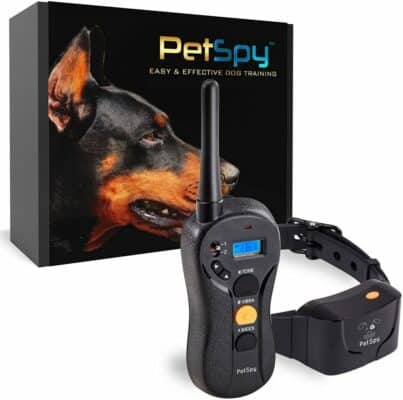
Editor’s Rating:
Why we like it: It has a sleek design and outperforms the cheaper models on our list.
Quick Facts:
- Modes: Vibration / Sound / Shock
- Remote Training Or Bark Sensor: Remote Training
- Range: 650 yards
One for the well-to-do among us, the PetSpy P620 costs approximately double the other options we’re recommending in this list. But if you don’t mind spending a bit more on a comfortable, durable, and stylish collar to keep your pet in check, then the extra 30 bucks or so will be well spent.
So what makes the PetSpy P620 worth the additional cash? First off, it’s one of the few shock collars on the market to fit and effectively train larger dogs. The maximum weight range in question is a whopping 140 pounds, enough to wrap comfortably around the neck of even the bulkiest furry beast.
This vibration, beep, and shock trainer comes with 16 sensitivity points on each mode, making it sufficiently simple to find the perfect setting for your pet. The big selling points, however, are its sleek and chic collar design plus user-friendly remote. The remote interface is easy enough to master by touch, so you won’t need to scroll through a whole host of options to bring up the setting you need.
It comes with a lifetime warranty and 24/7 customer support, a testament to the quality involved. PetSpy even throws in an e-book and video on how to safely train a dog so you won’t enter into the process blind.
Pros
- Easy to use interface
- Fits big dogs up to 140 pounds
- 16 sensitivity points on each mode
- Sleek collar design
Cons
- Expensive
6. Best for Two Dogs: Bousnic Dog Training Collar
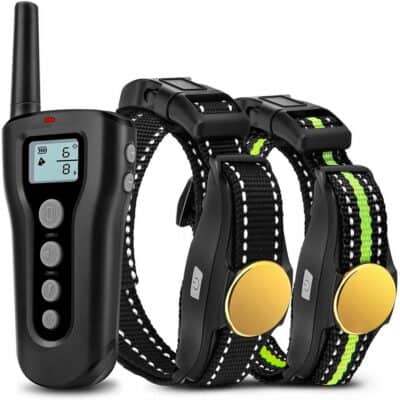
Editor’s Rating:
Why we like it: You get two high-quality receivers synced up to the same remote.
Quick Facts:
- Modes: Vibration / Sound / Shock
- Remote Training Or Bark Sensor: Remote Training
- Range: 1,000 feet
- Battery Life: 15-20 days
If you’ve got two misbehaving doggies to contend with, this double-receiver model from Bousnic could be the perfect option for you. With the one remote, you can discipline two separate dogs simultaneously, which is a godsend when you’ve got double trouble on your hands.
Bousnic strikes a brilliant balance between humane treatment and practical training. Comfortable silicone pads keep your fur baby feeling fresh throughout the day, and a respectable 16 shock point settings let you find the disciplinary sweet spot without being overzealous.
The “tone” function isn’t adjustable, so you’ll have to make do with tweaking the vibrations and static shocks instead. You also won’t get a built-in bark sensor included in the deal, so only grab this model if you’re ready to do the dirty work yourself.
An IP67 waterproof rating ensures the unit won’t cease to function in the wet, and it’s got an industry-standard range of 1,000 feet. Another neat plus is the battery life lasts longer than most—up to 20 days with regular use.
Pros
- Has two receivers
- Includes comfortable silicone padding
- Strong waterproof rating
- Solid 1,000-foot range
- Longer than average battery life
Cons
- Expensive
7. Best Long Range: PETDIARY Shock Collar for Dogs
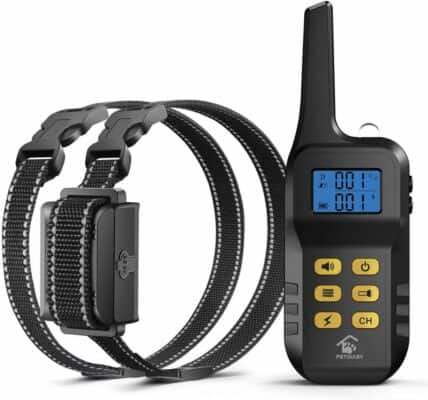
Editor’s Rating:
Why we like it: It has a longer range and battery life than most of its competitors.
Quick Facts:
- Modes: Vibration / Sound / Shock
- Remote Training Or Bark Sensor: Remote Training
- Range: 3,300 feet
- Battery Life: Remote 40 days / Collar 180 days
If you’re happy to spend a bit more on a premium product, this high-end option from PETDIARY is well worth a look. Not that it costs all that much, mind you, for this high-performance collar comes in at only a fraction more than most of the others on our list.
The big difference between PETDIARY and cost-effective brands is battery life. Rather than having to charge up the remote every couple of weeks, this unit will keep going for up to 40 days straight with regular use. As for the collar, you could squeeze 180 days out of it before it’s time for a battery change—that’s six whole months without running out of juice.
Another core advantage— this one is more for the country folk out there—is the extended maximum range. At 3,300 feet, the remote will work over three times the distance of most other dog training collars, which is brilliant for hunters who need to control an animal from afar.
As you’d expect from a premium product, you get all the main modes—sound, vibration, and shock—plus 100 sensitivity points on each for precise calibration.
This collar is also good for smaller dogs with a minimum weight of a petite 10 pounds, and the unit comes with a 12-month warranty to boot. We love the LED as well, which is easy to read and boasts a user-friendly interface.
Pros
- Long-distance remote
- Extended battery life
- Three modes with numerous sensitivity points
- Fits smaller dogs
- Comes with a 12-month warranty
Cons
- Expensive
8. Best Citronella Spray Collar: WWVVPET Citronella Dog Training Collar

Editor’s Rating:
Why we like it: This shock-free solution is perfect for dog lovers who don’t dare dabble with electricity.
Quick Facts:
- Modes: Vibration / Sound / Citronella spray
- Remote Training Or Barking Sensor: Remote training
- Range: 1,000 feet
- Battery Life: Remote 27 days / Collar 11 days
Citronella spray is the ideal alternative for dog lovers who can’t hack the thought of zapping their precious fur baby with an electric shock.
This model from WWVVPET comes with three modes, vibration, sound, and the citronella spray, the latter of which emits an annoying yet harmless and natural substance into the snout. Some studies have found citronella spray to be more effective at discouraging barking than an electric shock. Therefore, consider this unit if your main objective is some much-needed peace and quiet at home.
It’s perfect for little yappers as well, as the collar is rated to fit on teeny weeny doggos as small as 8 pounds. The big downside here is battery life; expect to charge up the collar every 11 days. You’ll have to refill the spray after every 30 or so uses, making the product more high-maintenance than others. It doesn’t work that well in wet conditions like rainy weather and soppy grass—which seems to be when our canine friends decide to act up the most.
Nonetheless, for a shock-free training experience without any guilty afterthoughts, citronella is the way to go.
Pros
- Citronella is effective at stopping barking
- Doesn’t physically harm the dog
- Good for small dogs
Cons
- Requires regular charging and refilling
- Doesn’t work well in rainy conditions
9. Best for Small Dogs: Enrivik Small Size Dog Training Collar
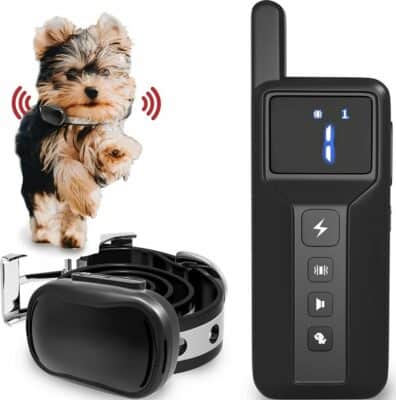
Editor’s Rating:
Why we like it: It works exceptionally well and fits on little dogs as small as 5 pounds.
Quick Facts:
- Modes: Vibration / Sound
- Remote Training or Bark Sensor: Remote Training
- Range: 1,000 feet
- Battery Life: 7 days
Anyone who’s ever owned a petite poodle or a tiny Chihuahua knows all too well that little dogs can have a big bad bark. And while most shock collars only fit well on dogs of 10 pounds or more, this miniature option from Enrivik is perfect for the pint-sized pooch.
The big selling point of this model is it comfortably fits doggies as small as 5 pounds, which means you’re good to go on pretty much any fully grown canine. Specifically, the adjustable collar stretches from 8 to 26 inches, so there’s no reason you can’t plop this around a bigger neck as well.
Of course, an electric shock could be harmful to a dog that small, which is why Enrivik has opted to go with vibration and sound modes only. Each mode has plenty of sensitivity points to choose from, and the remote comes with a respectable 1,000-foot range.
Do note that the battery in use here is only suitable for a week, so you’ll need to charge it up more often than other options on our list.
Pros
- Fits dogs as small as 5 pounds
- Strong 1,000-foot range
- Numerous sensitivity points on each mode
- No shock mode to avoid harming little dogs
Cons
- Battery only lasts one week
10. Safest Shock Collar: Authen Bark Collar
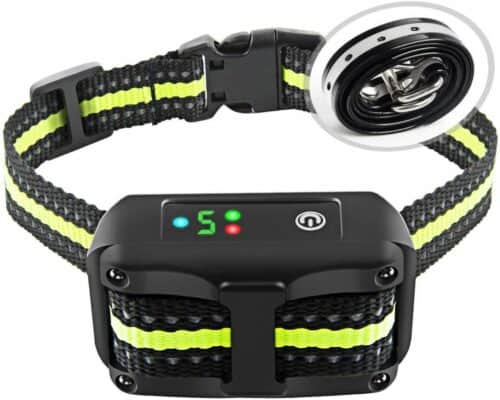
Editor’s Rating:
Why we like it: Its high-quality bark sensor and no-shock design keep even the yappiest dogs in line.
Quick Facts:
- Modes: Vibration / Sound / Shock (can be turned off)
- Remote Training Or Bark Sensor: Bark Sensor
- Range: N/A
- Battery Life: 12 days
If you prefer bark sensing collars to the remote training method but don’t want a product that can produce an electric shock, then have a look at this option from Authen.
The high-quality sensor uses a powerful microprocessor to accurately detect barks within a frequency of 1000 to 2000kHZ and a volume of 80 to 90db. That means your precious pooch will only ever be punished for unleashing loud and annoying barks rather than cute little rumbles. What’s more, you can turn the shock mode off entirely, which guarantees you’ll never accidentally emit a nasty zap. The sound and vibration modes have five sensitivity levels each, which is generally enough to discipline most dogs.
Another nifty feature is its intelligent protection system that sends a warning signal first, only administering punishment if a second bark occurs within 30 seconds. Clever doggies will realize what’s going on quickly and adjust their behavior accordingly.
Although the device boasts a respectable IP67 waterproof rating, its 12-day battery life is nothing to write home about.
Pros
- Highly tuned bark sensor
- Shock mode can be turned off
- Protection system gives a warning first
Cons
- Battery life isn’t the best
- Only five sensitivity levels
Shock Collars for Dogs: Buyer’s Guide
Taking the plunge and purchasing a shock collar for your dog is a big decision. Not only do you have the health and ethical implications to consider, but the best performing devices require a significant financial outlay.
To help you wrap your head around the product, we’ve put together an in-depth dog shock collar buyer’s guide. Here, you’ll learn everything there is to know about the various features, the potential for harm, and how to use one safely and responsibly.
Why You Should Buy a Training Collar for Dogs
As cute and loveable as our canine companions can be, even the most highly domesticated animals tend to misbehave from time to time. Whether it’s going potty on the carpet, playing rough with the kids, or threatening the neighbor’s puppy, our dogs can prove unpredictable at the best of times.
And then, of course, you’ve got the non-stop barking, which some particular breeds (we’re looking at you, poodles) have mastered to an art.
The ideal way to avoid these undesirable behaviors is by training your dog from birth. Using both positive reinforcement and negative reinforcement from a young age will dictate your dog’s behavior in later life, allowing you to enjoy a more harmonious relationship with your pup.
Nevertheless, proper training is easier said than done, especially for time-poor dog owners who have limited time to spend with their canine companions.
While the services of a professional dog trainer are unquestionably effective, their significant expense makes them beyond the average American family’s reach. A dog shock collar offers an affordable and convenient alternative that doesn’t separate you from your beloved pet. So if you’re the proud parent of a persistently problematic pup, then a dog shock collar could be the ultimate solution for you.
The Behavioral Issues a Dog Shock Collar Can Fix
Contrary to common belief, dog shock collars can fix a wide array of behavioral issues—they’re suitable for so much more than barking relief.
Barking
Incessant barking is, of course, the most common motivation for purchasing a shock collar for dogs. Even if you’re not too fussed about your fur baby’s “cute” little yaps, your neighbors might hold a different view.
A barking dog is among the most frequent cause of neighborhood disputes. Your dog could be barking away like mad the minute you leave home, disturbing the peace of everyone within earshot (the issue is exacerbated should you live in an apartment block). For all you know, you could be just one noise complaint away from eviction.
However, it’s essential to recognize dogs have a natural tendency to bark. If yours lets loose now and again, there’s no need to take action. But if your dog’s barking makes life miserable for those around you, a training collar is probably a sensible idea.
Aggressive Behavior
No matter how well behaved your pooch is around kids and other canines, there’s always the chance it’ll lose its patience and lash out one day. And should you have a large or aggressive breed like a Rottweiler or American Pit Bull, that momentary lapse of calm could have catastrophic results.
Fitting a shock collar with a remote training function can help you correct aggressive behavior the moment it occurs. Simply hit the button on your handheld remote, and the device will instantly deliver a response to discourage your pet from acting out. The process works wonderfully when your fur baby gets riled up upon meeting a nemesis pooch in the dog park (we’ve all been there).
Many owners of dogs, particularly the more aggressive breeds, strap a shock collar around their pets solely to deter this kind of aggressive behavior. In this situation, the collar would remain inactive 99% of the time.
Unsafe Exploration
If you’re worried about your four-legged companion breaking loose from the backyard and wandering around town, then opt for a different kind of shock collar with an in-built fencing feature. These cost substantially more than other shock collar types, so it’s only worth considering if containment is a major issue for you.
To operate the feature, you’ll need to bury a thin wire around the perimeter of your home (or the area where you’d like to restrict the animal). Should your pet cross over this invisible line, the collar will trigger a response to shepherd it back inside the safe zone again.
The technology works remarkably well as it doesn’t take long for a dog to figure out where it can and can’t go. The downside, however, is you’ll have to dig (and fill in) a tremendous ditch around the entire perimeter of your home.
Note that as these aren’t classified as shock collars for dogs, we’ve decided not to include any on our list.
Toilet Training
Nobody enjoys cleaning up dog poop from a formerly clean carpeted floor, which is why toilet training is an essential element of dog behavior management.
However, it’s important to note that puppy toilet training, A.K.A housebreaking is best done by establishing a routine and focusing on positive reinforcement.
If you’re struggling to train your puppy to do its business outside, the limited use of a training collar can be appropriate. Do not, however, use the electric shock function during toilet training; this mode should be used strictly as a last resort for severe behavioral issues. Instead, try using the audio or vibration mode on the lowest setting to discourage your pooch from peeing on the floor.
The Different Types of Dog Shock Collars

Dog shock collars come in one of two types: bark sensor collars and remote training collars. Each serves a distinct purpose, which we’ll outline below.
Bark Sensor Collars
Bark sensor collars are specially designed to train your dog not to bark, providing much-needed peace and quiet for you and everyone in the immediate vicinity. Rather than having to personally punish your dog every time it barks, the device will automatically elicit a response when its in-built microphone detects noise above a set decibel rating.
Although the bark sensor collars of old had trouble distinguishing your dog’s bark from others—thus punishing them unjustifiably—newer versions are superb at only responding to your dog’s unique bark.
Remote Training Collars
Bark sensor collars are only effective at discouraging a dog from barking. If you’d like to rectify another issue—aggressive behavior, toilet training, overfeeding, etc.—then a remote training collar is the way to go.
With these, the owner must manually activate the collar through a handheld remote. By doing so mercifully at the correct time, they can use negative reinforcement as a tool to better train their pet.
The Different Modes of an Electronic Training Collar for Dogs
The different modes you have to choose from depends on the specific dog shock collar you purchase. Note that each mode has varying levels of intensity (known in the industry as sensitivity), and it’s best to start on a low setting before working your way up.
Given the electric shock mode must only be used as a last resort, it’s sensible to invest in a collar that includes several less intrusive responses as well.
Vibration Response
A popular and harmless mode found on many dog shock collars is vibration, which causes the collar to vibrate either on command or when the dog barks. Rather than being painful like an electric shock, the pulse is more of a nuisance that annoys the dog.
Audible Response
Another widely used and reasonably humane mode is the audible response, which emits a high pitch frequency to train your dog. Dogs have highly sensitive hearing, so even a small noise at the right frequency will be enough to create a sense of discomfort.
Even at the highest setting, the frequency emitted is inaudible to humans, so you won’t have to worry about a double-whammy—an annoying bark followed by an annoying beep. One thing to keep in mind, however, is any dogs in the immediate vicinity will also find the sound offensive. It’s a bit unfair to use one when your pet is in close contact with other canines.
Citronella Spray Response
Although less popular than other modes, a citronella spray can be an effective way of training a dog, especially for consistent behavioral issues such as barking. The device emits a fine mist of liquid onto the dog’s nose every time it barks, and your pooch should find it irritating enough to serve as sufficient discouragement.
Citronella sprays only release a short burst, so you don’t need to worry about messy cleanups and perpetually soggy snouts. It’s an unobtrusive way to train an animal, which is perfect when you’re worried about hurting your loved one.
Electric Shock Response
The most severe mode is the electric shock, which emits a pulse of electricity onto a series of contact points that startles the dog and discourages it from behaving in the same way. Some manufacturers refer to this procedure as static electricity or electric stimuli to downplay the discomfort it causes.
In reality, even on the lowest setting, the electric shock mode causes a degree of discomfort, especially if emitted frequently. Your dog may even begin to associate the pain with you rather than the behavioral issue you’re hoping to modify, which is counterproductive to the training process.
Safety Considerations When Using a Dog Shock Collar
Dog shock collars are a controversial device that some animal enthusiasts abhor, despite never having used one themselves. Although it’s undeniable the shock mode causes some pain to your pet, the degree of discomfort is entirely dependent on how you configure the settings.
Always opt for a lower setting first and only distribute shocks for major behavioral offenses. As in the human world, the punishment must fit the crime. If you’re consistently shocking your dog on a moderate to high setting, then you’re administering a cruel and undue punishment and should consider adopting another approach.
When fitting the collar, pay close attention to the manufacturer’s instructions. Ensure the contact points only align with the neck rather than the throat, and that the collar isn’t in danger of coming loose.
It’s also worth noting the dog shock collars of old are far less humane than the later models. This technology has been around since the 60s, and the more recent incarnations are less likely to result in injury than they used to be. Furthermore, we only recommend products that cause minimal pain to your pet.
Finally—and most importantly—only use the shock function as a last resort. Try to resolve the issue first through the vibration, audio, or spray mode before switching to electric.
How to Train Your Dog With a Shock Collar
Dog shock collars are a favorite tool among police trainers and hunters for their ability to provide instant negative reinforcement to shape an animal’s behavioral patterns. And while the device can be equally effective in a domestic setting, it’s crucial to put positive reinforcement first.
The best way to train a dog is by providing rewards such as pats and treats when it’s done the right thing. A canine is far more likely to associate a reward with good behavior than punishment with bad behavior. Overzealous shocking can cause your pet to link you, rather than their behavior, to the punishment, prompting them to act unpredictably or aggressively.
In short, aim to make positive reinforcement the basis of your training regime and use negative reinforcement sparingly to fill in the gaps.
FAQ
If you’ve still got questions about the dog shock collar, then take a browse through our FAQ.
Do Shock Collars Hurt Your Dog?
If used properly and sparingly, a shock collar won’t cause any long-lasting physical or emotional harm to a dog. The lowest level of the electric shock mode is more of an annoyance than electrocution, while the vibration mode is equivalent to a cellphone buzzing in your pocket.
If used excessively and on the higher settings, however, constant use of the electric shock mode can cause significant discomfort and permanent damage to the tissue in your dog’s neck. Ultimately, it’s the owner’s responsibility to use the device humanely.
Is It Legal to Put a Shock Collar on a Dog?
Yes.
No American state legislates against the use of shock collars for dogs. Excessive and unreasonable use may be a form of animal cruelty, however, and the onus is on the owner to administer justifiable punishments to their pets.
When Should You Start Using a Dog Shock Collar?
While some manufacturers claim you can begin using a dog shock collar as early as ten weeks, it’s wise to proceed with caution.
Dogs don’t mature emotionally until 6-12 months, and excessive negative reinforcement can lead to anxiety and aggression later in life. If you decide to use a shock collar before the 6-12 month mark, opt for the least invasive vibration setting.
Can Shock Collars Make Dogs More Aggressive?
If used too frequently in an excessively high setting, dog shock collars can have an adverse impact on your four-legged friend’s emotional wellbeing. Overzealous negative reinforcement may cause your dog to become fearful and aggressive, especially if administered too early in its lifespan.
Do Citronella Spray Collars Work?
Yes.
A study by Cornell University’s College of Veterinary Medicine found citronella spray collars to be the most effective way to combat nuisance barking.
Will a Shock Collar Stop a Dog Fight?
In most situations, yes.
The electric shock will discourage the dog in question from continuing the fight and teach it to refrain from acting violently towards other animals in the future. However, it won’t necessarily stop the other dog from escalating the scuffle.
Do Police Trainers Use Dog Shock Collars?
Yes.
Both police K-9 units and hunters use dog shock collars to train their animals. The type of training done here is quite different from domestic use.
Shock Collars for Dogs: Final Thoughts
If you’ve made it this far through our guide, you’re now an expert on the effectiveness and ethics of the shock collar for dogs. We’ve covered why you should buy one, the behavioral issues they can correct, the different modes and types, and the essential safety considerations.
All that’s left to do now is revisit our top things to consider and peruse our top 10 shock collars for dogs to find the ideal option for you.
Once your new training collar has arrived in the post, you’ll be able to enjoy the good behavior of your favorite companion for years to come, 100% bark-free.





